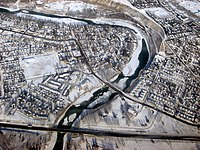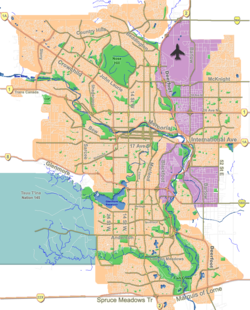Bowness, Calgary
| Bowness | |
|---|---|
| Neighbourhood | |

Aerial view of Bowness
|
|
| Location of Bowness in Calgary | |
| Coordinates: 51°05′28″N 114°11′57″W / 51.09111°N 114.19917°WCoordinates: 51°05′28″N 114°11′57″W / 51.09111°N 114.19917°W | |
| Country |
|
| Province |
|
| City |
|
| Quadrant | NW |
| Ward | 1 |
| Established | 1896 |
| Village | February 14, 1948 |
| Town | November 5, 1951 |
| Amalgamated | August 15, 1964 |
| Government | |
| • Mayor | Naheed Nenshi |
| • Administrative body | Calgary City Council |
| • Councillor | Ward Sutherland |
| Elevation | 1,080 m (3,540 ft) |
| Population (2008) | |
| • Total | 11,308 |
| • Average Income | $40,468 |
| Website | Bowness Community Association |
Bowness is a neighbourhood and former town in west Calgary, Alberta, Canada. The former town was amalgamated into the City of Calgary in 1964.
The neighbourhood is bordered by the Bow River to the north and east, 16 Avenue to the south, and Stoney Trail to the west. The neighbourhood of Montgomery, another former town amalgamated into the City of Calgary a year earlier in 1963, is located across the river to the east.
On the northwest end of the community is one of Calgary's most popular parks, Bowness Park. The park sits between the Bow River and a lagoon, and is popular for picnics, summer sports, ice skating in the winter, and boating. It is also part of the city's large pedestrian pathway network. It is bordered by Edworthy Park to the southeast.
Bowness is represented in the Calgary City Council by the Ward 1 councillor. Residents of the area are called "Bownesians" (Bow-NEE-zhins).
The community has an area redevelopment plan in place.
The Bow Valley, where Bowness is situated, has been occupied by native peoples since the end of the last ice age, around 10,500 years ago. Archeological evidence shows that the Nitsitapii (Blackfoot) have been in the area for over a thousand years, with Stoney, Cree and Tsuu T'ina peoples arriving from the sixteenth century onwards. Non-natives reached the region in the late 1700s, after which native populations began to decline rapidly, due to epidemics and the decimation of the bison herds on which they depended. In 1877, the Blackfoot, Blood, Peigan, Tsuu T'ina and Stoney First Nations signed Treaty 7, accepting to live on reserves that covered some of their traditional hunting grounds.
...
Wikipedia

